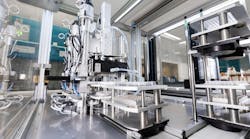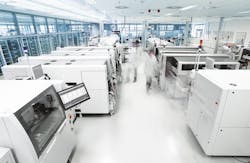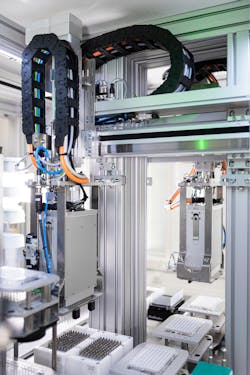Some 110 years ago, Henry Ford was quoted as saying, “Any customer can have a car painted any color that he wants as long as it is black.” His revolutionary idea was that with less variation, assembly line strategies would increase output, drive down cost, and expand automobile ownership to the masses. Had Ford been able to add Industry 4.0 concepts to his assembly line, he might instead be quoted today as saying, “Any customer can have a car painted in any color he or she wishes, and have it done quickly with high quality at a competitive price.”
This combination of strategies has relevance to the laboratory device and biopharma industries searching for solutions that have the potential to drive down healthcare costs. It is clear that many of the Industry 4.0 concepts used in this technology are also applicable to wider principles of machine design. And, the importance of weighing the relative benefits of parallel vs. serial processing when scaling up production also has ramifications beyond medical device design.
Modular assembly line at Festo’s Scharnhausen, Germany production plant is based on Industry 4.0 and cyber-physical system concepts.
Recently, Synchron and Festo applied assembly line strategies with Industry 4.0 concepts to laboratory automation for the extraction of plant DNA for an agricultural genetics company. This first-of-its-kind DNA extraction device increased output from an industry average of about 5,000 extractions per day to up to 40,000—an eightfold increase. The key to the device’s success is an ordinary conveyor transporting samples from process to process.
Contrast this assembly line approach with the typical extraction scenario of completely processing a single set of samples before starting on the next. The typical laboratory device for extracting DNA features a robotic handling system completing one set of samples and then starting on the next. Samples are usually extracted from a 96-well microliter plate, where each plate may require up to 20 minutes for processing. Many machines have two robots extracting DNA in parallel. These dual systems can achieve a throughput of up to 5,000 samples per day on 52 microliter plates.
This was the state of affairs when an agricultural genetics company involved in seed development came to Synchron and asked the following question: Can a machine be built on a small footprint for a relatively modest cost to achieve upwards of 40,000 DNA extractions per day?
Any company with a background in “typical laboratory devices” would automatically begin, as Synchron did, by considering scaling up the number of robots required—e.g., two robots in parallel for 5,000 extractions, four robots using parallel processing for 10,000, and so on, up to 16 robots extracting DNA in parallel. The cost of a 16-robot solution, however, would be astronomical, not to mention the enormous footprint required. The number of attendants would increase, as would the complexity of technical support. The acquisition of replacement parts in terms of speed and downtime would pose logistics issues. It was clear that scaling up parallel processes would not be a viable option.
Perhaps, the designers thought, \the solution would be to speed up the extraction process so that fewer robots could do more. But pipetting and handling liquids at the higher rates required posed significant technical and cost challenges. Speeding up the extraction process seemed to be a dead end.
Pipettes about to enter the DNA samples.
Field Trips Can be Worthwhile!
The design team at Synchron met with Festo, one of its principal automation partners, to discuss the challenge. During the meeting, Synchron was invited to Festo’s plant in Scharnhausen, Germany to view the latest in manufacturing technology. During the field trip, Synchron toured the new valve assembly line, a production line based on Industry 4.0 and cyber-physical system concepts. On that line, manufacturing modules are controlled and monitored by computer-based algorithms tightly integrated with the internet and the operations team. Like Henry Ford’s assembly line, each module performs a simple operation; the valve then moves to the next station/operation. On this line, cyber-physical capabilities alter the operation of every module on demand and in real time to customize the valve—figuratively painting the valve any color.
The valve assembly line started Synchron engineers asking, why not place the microwell plates on a simple conveyor and move each plate from station to station? Rather than having two plates being extracted in parallel, have numerous plates being extracted in series. Taking that thought in a new direction, the design team theorized that with radio frequency identification (RFID) tags and Industry 4.0 concepts, each plate could receive unique DNA extraction processing for greater flexibility. In other words, Henry Ford meets Industry 4.0.
Serial processing via conveyor would potentially solve many of the design issues that parallel processing posed: The footprint would be smaller. Operator headcount would be the same as a two-robot system. The issue with parts would be basically the same as a two-robot system. And significantly, the cost would be significantly lower than scaling up to a 16-robot solution.
Side-by-side 96 well disposable tip aspirate/dispense heads are used for adding beads and binding buffer to the samples in the first step of the process, as well as doing the final quick wash and elution at the last step of the process.
What About Throughput?
Looking at processing 96-sample microplates on a loop conveyor assembly line, Synchron calculated that the first microplate would require up to 20 minutes to process, about the same amount of time as in robot handling. After the first unit, however, a microplate would come off the assembly line every 2.5 min. or less for up to 200 microliter plates per eight hours. This was close to the eight-times increase the customer had asked for.
How the DNA Extraction Machine Operates
The DNA extraction on the new Synchron DNA Cruiser begins with a holder that accommodates up to 400 microwell plates—200 for input and 200 for output. A bar code reader scans all the microwell plates at the start of a run. Electric axes, in combination with a semi-rotary drive and a gripper, pick up the microwell plates and place each on carriers that move through the various stations on a simple conveyor system. Metal microspheres are added to separate the DNA from the other material. The DNA attaches itself to the microspheres, while the residual floats up in the microwell plates. Liquid is added to and extracted from the microwell plates at several washing stations. The pipetting head is lowered by an electric slide during this process. After rinsing, clean DNA remains in the microwell plate and is fed to the final processing step: namely, DNA extraction.
The pipetting head for extracting the DNA is handled by an electric axis in combination with an electric slide. There are almost no switching delays between actions. For high data input on the status of components, IO-Link technology is utilized. The control platform for the device acts as a remote I/O system for a master discrete and motion controller.
Carriers with samples containing DNA bound to magnetic beads in 96 well plates are cueing to be washed by the DualWash heads.
Lessons Learned
The paradigm shift from parallel processing to Henry Ford assembly line/Industry 4.0 concepts has opened a whole new set of opportunities for the laboratory device and biopharma industries. Each station can be designed and cost-effectively built as a standalone unit and simply added to other modules (Lego-brick fashion) to create a custom process. Complex processes would have many modules while smaller and lower volume would have fewer.
In terms of flexibility, loop conveyors lend themselves to having branch conveyors where samples could be routed for specialized operations or used as accumulation buffers. RFID tags would specify the process for each microliter plate and record every process performed on the sample for traceability. The footprint of these systems is a fraction of what it would take with parallel handling. The assembly line/modular stations have application for processes as well as for discrete operations, where complex processes can be carried out by linking various process modules.
Industry 4.0 systems as envisioned here are operator independent in that the recipe for each set of samples is downloadable from the master controller or from a cloud-based system. The system does not require input from an operator when recipes change. This helps to minimize headcount and reduces the opportunity for operator error.
Components in these systems can be off-the-shelf and industrial grade as opposed to home-grown, black-box solutions. Sourcing components from leading industrial manufacturers means that replacement parts can typically arrive in days or even hours, not weeks. Supplier provided subassemblies and kits reduce engineering time and help original equipment manufacturers bring products to market faster. Industrial components suppliers have extensive technical support networks accessible 24/7, and industrial components are typically competitively priced.
Industry 4.0 industrial systems based on technologies such as IO-Link intelligent components are moving toward predictive maintenance, where sensors monitor the health of components and warn when an issue is developing. Predictive maintenance systems can be cloud- or mobile computing-based for rapid status alerts. Predictive maintenance leads to higher uptime and optimum throughput.
In an era where health care costs are climbing, assembly line/Industry 4.0 concepts for both discrete and process laboratory device and biopharma applications offer a path toward higher volume throughput at lower cost. And, as stated earlier, many of these concepts have application across automation generally.
Niels Kruize is business development manager at Synchron. Craig Correia is the director of Life Science & Process Industries, North America at Festo.





